Key takeaways
- Slack’s organization through channels, direct messages, and threads enhances communication, making it easier to focus on specific topics and projects.
- Effective communication is crucial in programming to prevent misunderstandings and improve collaboration, often saving time on rework.
- Slack’s integrations and search functions streamline developers’ workflow by providing quick access to relevant updates and discussions.
- Customizing notifications and using threads can help manage distractions, leading to clearer communication and improved productivity.
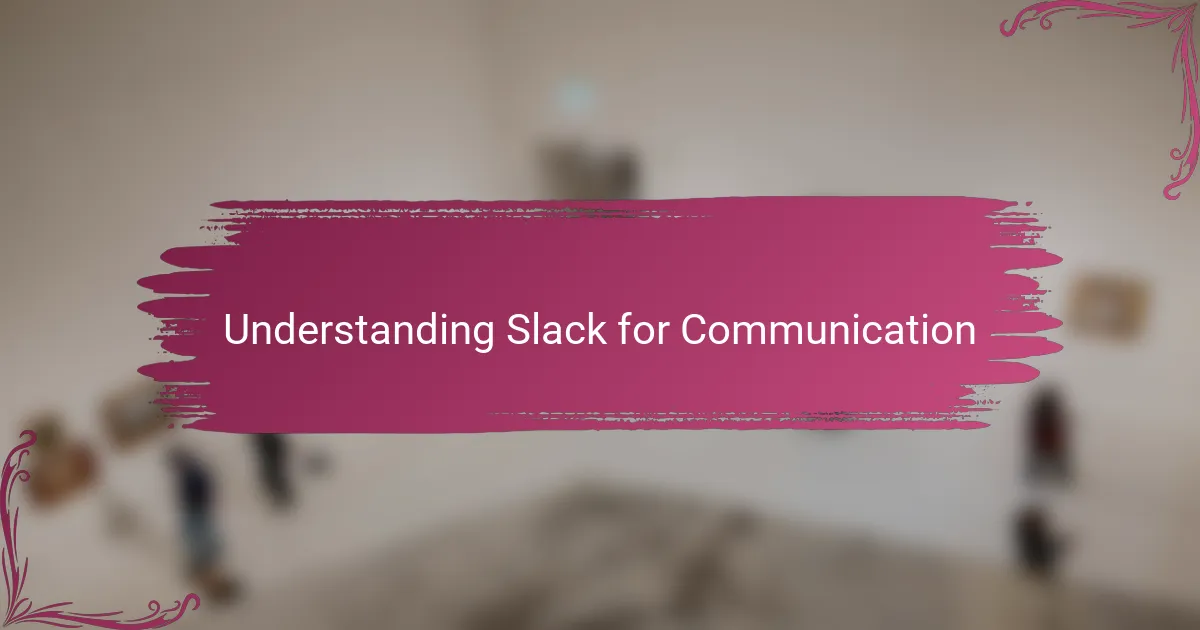
Understanding Slack for Communication
When I first started using Slack, I was struck by how its structure mirrors real-life conversations but with the flexibility to pause and pick up later. Channels, direct messages, threads—they each offer a unique way to keep discussions organized, which I found crucial when juggling multiple projects. Have you ever struggled to track down an important message buried deep in your email inbox? Slack solves that problem elegantly by segmenting conversations by topics or teams.
From my experience, understanding Slack’s communication model is like learning a new language at first, but once you get it, everything flows much more smoothly. The ability to create dedicated channels for specific topics or projects reduces noise and keeps the focus sharp. It’s a bit like having different rooms for different purposes—no more shouting across a noisy office to get someone’s attention.
What truly stands out to me is how Slack balances synchronous and asynchronous communication. You can catch someone immediately or leave a message they can respond to when convenient. Isn’t that freedom a big part of why remote teams thrive on Slack? This flexibility reshaped the way I think about workplace communication.

Importance of Communication in Programming
Communication in programming is more than just exchanging code snippets or bug reports; it’s the backbone of collaboration. I’ve noticed that without clear communication, even the simplest tasks can become tangled in misunderstandings. Have you ever been stuck because a teammate’s intentions weren’t clear? That frustration is a common hurdle that effective communication can easily overcome.
When I reflect on successful projects, it’s clear that good communication was always at the heart of progress. It’s not just about talking more, but about sharing information in ways that everyone on the team can understand and act upon. I’ve seen firsthand how a quick clarifying message can save hours of rework, which makes all the difference under tight deadlines.
Also, programming often involves problem-solving across different expertise levels. I find that bridging these gaps requires patience and well-structured communication. Asking the right questions and actively listening have helped me avoid costly assumptions. Isn’t it interesting how a few thoughtful words can align the whole team toward the same goal?
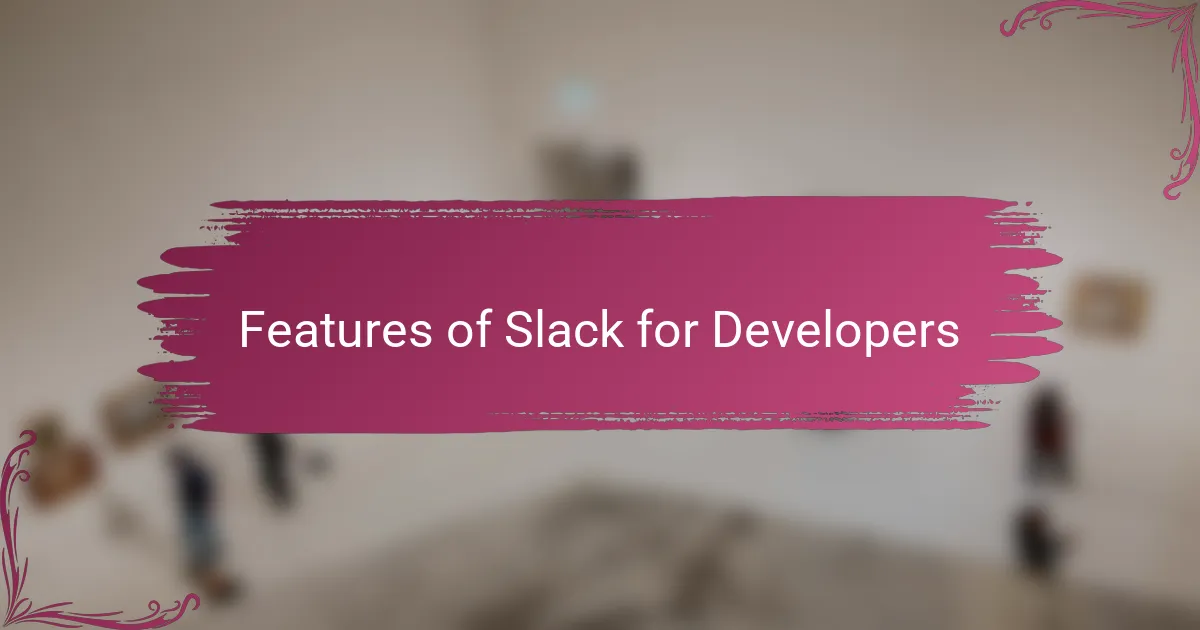
Features of Slack for Developers
One feature of Slack I’ve come to rely on is its seamless integration with development tools like GitHub and Jenkins. When a code repository activity pops up directly in a channel, it feels like the whole team is instantly in the loop—no need to switch apps or hunt down updates. Have you ever missed a critical code review comment because it was buried in an email thread? Slack helps avoid that mess effortlessly.
I also appreciate Slack’s powerful search function. Scrolling through endless messages used to drive me nuts, but now I just type a keyword or a developer’s name, and I’m right back to the exact snippet or discussion I need. It saves me tons of time, especially during crunch periods when every second counts.
Another underrated feature is the ability to create custom workflows and automate routine notifications. At one point, I set up a Slack bot to remind the team about daily stand-ups and push deployment alerts. That little automation lifted some of the mental load off my shoulders and kept communication crisp. Have you ever tried automating your own Slack channels? It’s surprisingly satisfying.
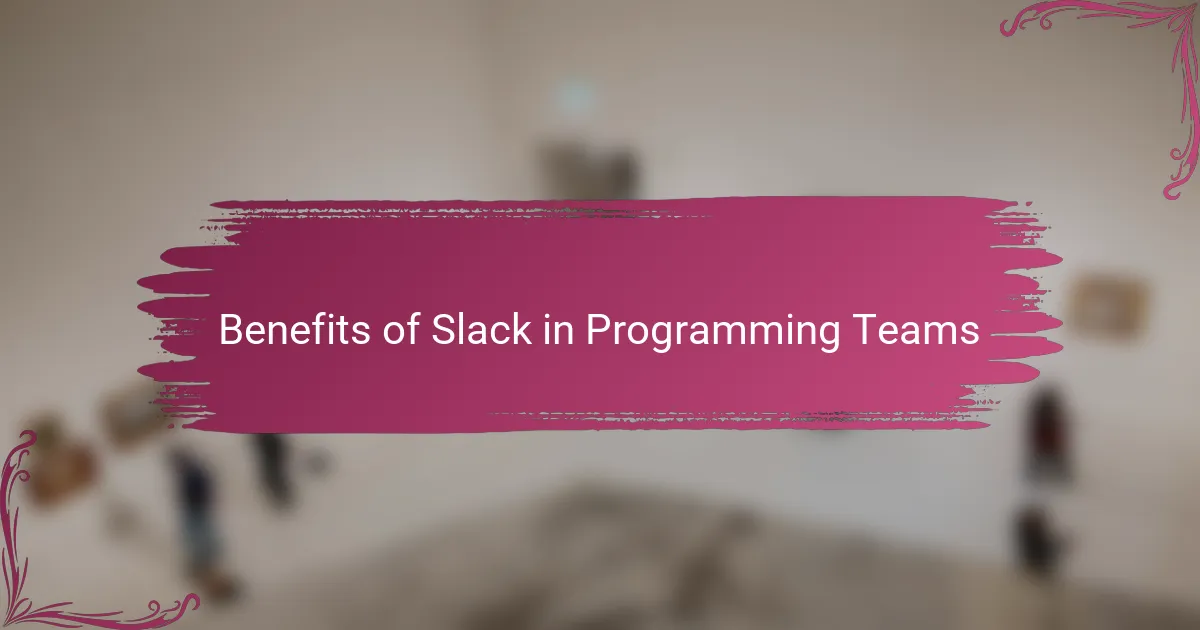
Benefits of Slack in Programming Teams
What I find most rewarding about Slack in programming teams is how it keeps everyone connected without drowning them in noise. Creating channels for topics like frontend bugs or feature requests means I never feel lost in a sea of unrelated chatter. Have you ever been in a meeting where half the conversation didn’t even apply to you? Slack cuts through that by letting each person focus only on what matters to them.
I’ve also noticed how Slack encourages faster problem-solving. When a tricky bug pops up, I can quickly ping the right teammate in a thread dedicated to that issue. This immediacy speeds up discussions and reduces waiting times that usually drag projects down. Isn’t it great when you can keep the momentum going without endless back-and-forth emails?
Another thing I appreciate is how Slack helps build team culture, even remotely. Sharing quick jokes, code snippets, or celebrating small wins in dedicated channels creates a sense of belonging. From my experience, this casual interaction makes tough deadlines feel less stressful and keeps morale high. Doesn’t a friendly chat sometimes make all the difference in a programmer’s day?
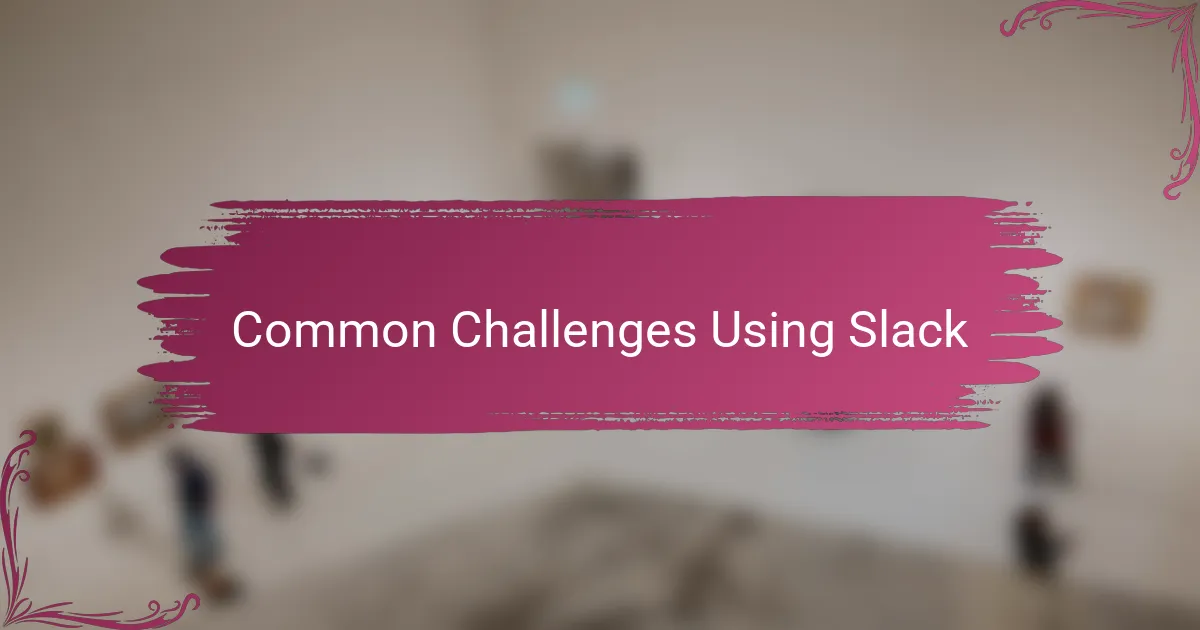
Common Challenges Using Slack
One challenge I often face with Slack is the sheer volume of notifications. Early on, I felt overwhelmed by constant pings, which made focusing on coding harder than it needed to be. Have you ever found yourself distracted mid-task because of a barrage of Slack alerts? Finding the right balance between staying informed and avoiding notification overload took me a while.
Another common hurdle is managing message clutter. Even with channels and threads, important points sometimes get lost in endless streams of chatter. I remember one time searching desperately for a key decision buried several days back—it was frustrating and slowed down progress. Don’t you think it’s ironic how a tool meant to improve communication can sometimes make it harder to find what really matters?
Lastly, navigating asynchronous responses can be tricky. When teammates are in different time zones, conversations can stall, leaving me wondering if my message was seen. I’ve learned to adapt by setting clear expectations about response times, but that uncertainty still gnaws at me occasionally. Have you found yourself waiting on a Slack reply that never came when you needed it most? It’s a common pitfall that keeps me cautious about relying solely on Slack for urgent issues.
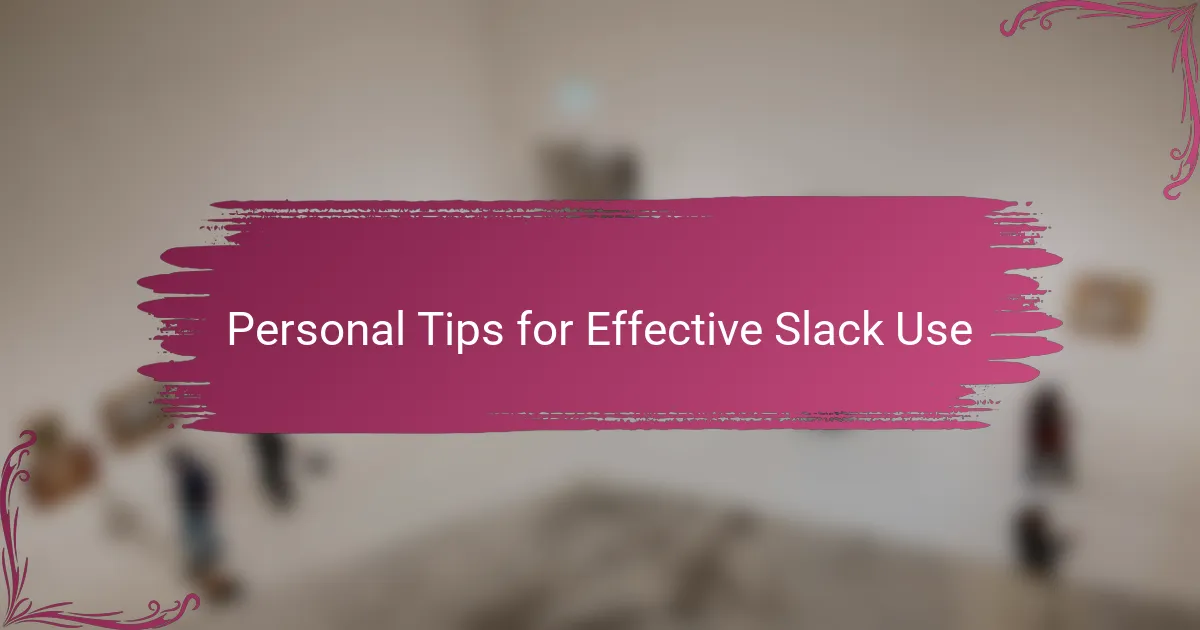
Personal Tips for Effective Slack Use
One tip I’ve found invaluable is customizing my notification settings. At first, I left everything on, and it felt like my phone was constantly buzzing—distracting me from deep work. Have you ever had that experience where a ping pulls you away just as you’re hitting your stride? Narrowing alerts to only critical channels made a world of difference in keeping my focus intact.
I also make it a habit to use threads religiously. It’s tempting to reply in the main channel for speed, but I’ve noticed that sticking to threads keeps conversations tidy and context intact. This practice saved me on more than one occasion when I needed to revisit a discussion without wading through unrelated messages. Don’t you agree that fewer distractions mean clearer communication?
Lastly, I recommend setting a daily “Slack check-in” routine instead of constantly monitoring messages. Early in my career, I felt pressured to respond instantly, which was exhausting and counterproductive. Now, allocating specific times to catch up helps me manage my energy and respond thoughtfully. Have you tried this approach? It’s surprisingly liberating and boosts productivity more than you’d expect.
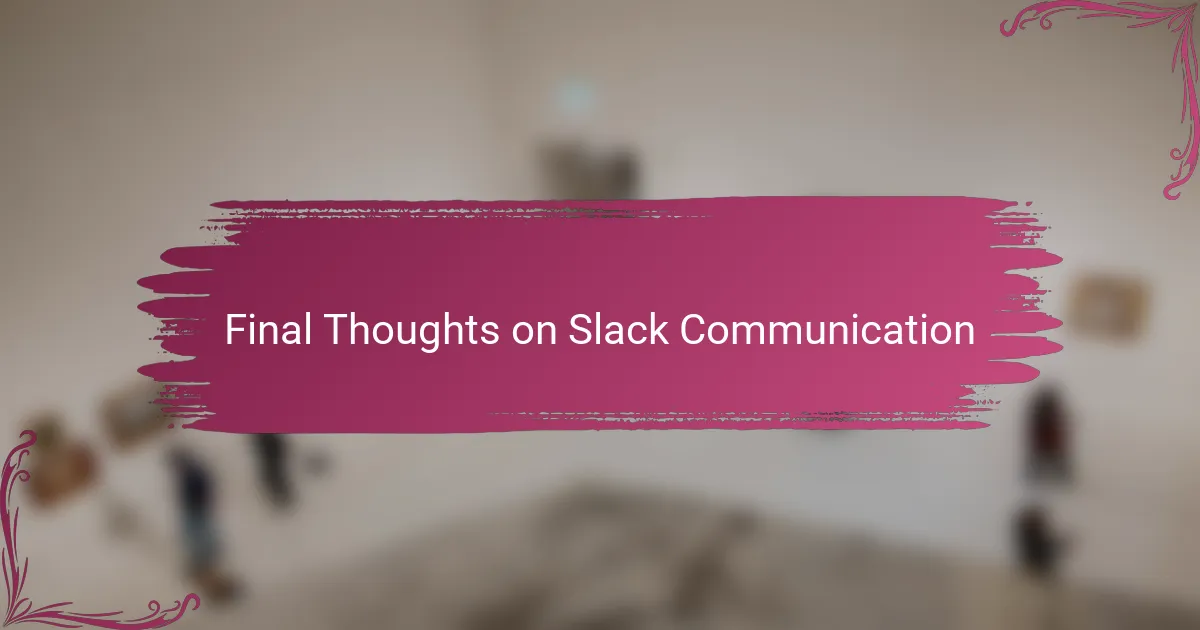
Final Thoughts on Slack Communication
Looking back, Slack has proven to be a game-changer for how I communicate within programming teams. Sure, it’s not perfect—notification overload and message clutter can still test my patience—but its structure and flexibility outweigh those hassles. Have you ever felt that rush when a Slack thread quickly resolves a complex issue without needing a meeting? That sense of instant, focused collaboration is what keeps me coming back.
Sometimes, I catch myself appreciating the subtle ways Slack shapes team dynamics. It’s not just about exchanging information; it’s about creating an environment where questions get answered, ideas flow, and even small celebrations happen in real time. From my perspective, this human touch is what makes technical work feel less isolating, especially during long coding sprints.
In the end, effective Slack communication boils down to balance and intentionality. I’ve learned that setting boundaries and using its features thoughtfully helps me stay productive without feeling overwhelmed. Isn’t it interesting how a tool can change not just how we work, but how we connect? For me, Slack remains a vital part of that ongoing journey.